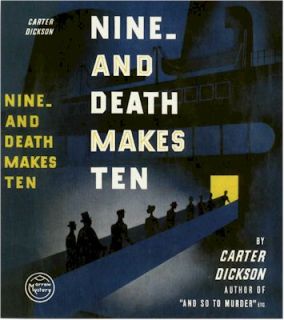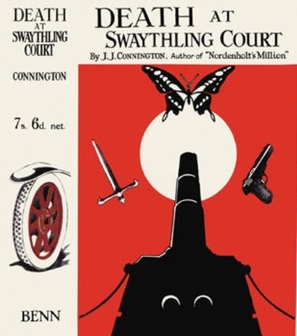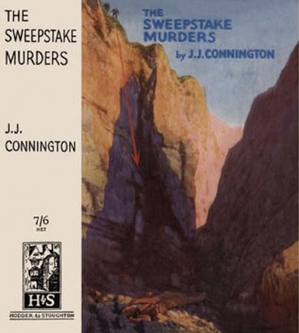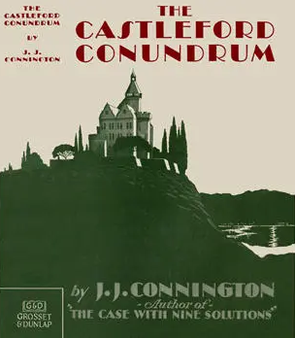
Detective fiction is a subgenre of crime fiction and mystery fiction in which an investigator or a detective—whether professional, amateur or retired—investigates a crime, often murder. The detective genre began around the same time as speculative fiction and other genre fiction in the mid-nineteenth century and has remained extremely popular, particularly in novels. Some of the most famous heroes of detective fiction include C. Auguste Dupin, Sherlock Holmes, Kogoro Akechi, and Hercule Poirot. Juvenile stories featuring The Hardy Boys, Nancy Drew, and The Boxcar Children have also remained in print for several decades.

Mystery is a fiction genre where the nature of an event, usually a murder or other crime, remains mysterious until the end of the story. Often within a closed circle of suspects, each suspect is usually provided with a credible motive and a reasonable opportunity for committing the crime. The central character is often a detective, who eventually solves the mystery by logical deduction from facts presented to the reader. Some mystery books are non-fiction. Mystery fiction can be detective stories in which the emphasis is on the puzzle or suspense element and its logical solution such as a whodunit. Mystery fiction can be contrasted with hardboiled detective stories, which focus on action and gritty realism.

The Floating Admiral is a chain-written, collaborative detective novel written by fourteen members of the British Detection Club in 1931. The twelve chapters of the story were each written by a different author, in the following sequence: Canon Victor Whitechurch, G. D. H. Cole and Margaret Cole, Henry Wade, Agatha Christie, John Rhode, Milward Kennedy, Dorothy L. Sayers, Ronald Knox, Freeman Wills Crofts, Edgar Jepson, Clemence Dane and Anthony Berkeley. G. K. Chesterton contributed a prologue, which was written after the novel had been completed.

The Winter Murder Case (1939) is a Philo Vance novella that S. S. Van Dine intended to expand into his twelfth full-length book, a project cut short by his death. The Winter Murder Case seems especially similar to the B mystery movies of the 1930s, a cross between Van Dine's usual style and the film style. It was intended as a vehicle for Sonja Henie.

Innocent Blood (1980) is a crime novel by English writer P. D. James. Unlike her Adam Dalgliesh mysteries it is not a detective story but closer to a psychological thriller and was the first of James' novels to step outside the detective genre. It follows the story of a young woman searching for her biological roots, having known since childhood that she was adopted, and the dark truths that she uncovers.

Death in Five Boxes is a mystery novel by the American writer John Dickson Carr, who published it under the name of Carter Dickson. It is a whodunnit and features the series detective Sir Henry Merrivale and his associate, Scotland Yard's Chief Inspector Humphrey Masters.

Murder in the Submarine Zone is a mystery novel by the American writer John Dickson Carr, who published it under the name of Carter Dickson. It is a whodunnit and features the series detective Sir Henry Merrivale.

She Died a Lady is a mystery novel by American writer John Dickson Carr, who published it under the name of Carter Dickson. It is a whodunnit featuring the series detective Sir Henry Merrivale.

Leslie S. Klinger is an American attorney and writer. He is a noted literary editor and annotator of classic genre fiction, including the Sherlock Holmes stories and the novels Dracula, Frankenstein, and Strange Case of Dr. Jekyll and Mr. Hyde as well as Neil Gaiman's The Sandman comics, Alan Moore's and Dave Gibbons's graphic novel Watchmen, the stories of H.P. Lovecraft, and Neil Gaiman's American Gods.

Close Quarters is the first novel by the British mystery writer Michael Gilbert. Published in England by Hodder and Stoughton in 1947, it did not appear in the United States until 1963. By then Gilbert's reputation had been firmly established in both countries and his regular American publisher for many years had been Harper & Brothers. Close Quarters, however, was published by Walker and Company, a less prestigious house. In it we are introduced to Chief Inspector Hazlerigg, who will go on to be a recurring character in a number of Gilbert's works throughout the next ten years. Gilbert, who was appointed CBE in 1980, was a founder-member of the British Crime Writers' Association. The Mystery Writers of America named him a Grand Master in 1988 and in 1990 he was presented Bouchercon's Lifetime Achievement Award.

Red Threads is a mystery novel by American writer Rex Stout, starring his detective Inspector Cramer, first published in 1939. Police Inspector Cramer was the protagonist of one mystery written by Stout in 1939.

The Birthday Murder is a 1945 novel by American author Lange Lewis. The story follows the Los Angeles lieutenant Richard Tuck, who is investigating the murder of movie producer Albert Hime and his wife, Victoria Jason Hime, who wrote a novel where a woman's husband is killed in similar circumstances. Published by Bobbs-Merrill, it received positive reviews from critics.

Mystery at Lynden Sands is a 1928 detective novel by the British author Alfred Walter Stewart, published under his pseudonym J.J. Connington. It is the third in a series of novels featuring the Golden Age Detective Chief Constable Sir Clinton Driffield. It was published in London by Gollancz and Boston by Little, Brown and Company. It received a generally positive critical reception, with one reviewer going so far as to say it "may just fail of being the best detective story of the century" comparing it to The Cask and The Mysterious Affair at Styles. In A Catalogue of Crime by Jacques Barzun and Wendell Hertig Taylor describe it as "early but not first-class Connington".

Death at Swaythling Court is a 1926 mystery detective novel by the British writer Alfred Walter Stewart, published under his pseudonym J.J. Connington. It was Stewart's first attempt at a detective novel, having previously produced works including the 1923 science fiction novel Nordenholt's Million. It is a stand-alone novel, revolving around a country house mystery. The following year the author published Murder in the Maze, the first of seventeen novels featuring the Golden Age detective Sir Clinton Driffield, for which he is best-known.

The Boathouse Riddle is a 1931 detective novel by the British author Alfred Walter Stewart, published under his pseudonym J.J. Connington. It is the sixth in his series of seventeen novels featuring the Golden Age Detective Chief Constable Sir Clinton Driffield. The title is also written as The Boat-House Riddle.

The Sweepstake Murders is a 1931 detective novel by the British author Alfred Walter Stewart, published under his pseudonym J.J. Connington. It is the seventh in his series of novels featuring the Golden Age Detective Chief Constable Sir Clinton Driffield. It uses a tontine murder theme, which recurs in detective and mystery stories.

The Castleford Conundrum is a 1932 detective novel by the British author Alfred Walter Stewart, published under his pseudonym J.J. Connington. It is the eighth in his series of novels featuring the Golden Age Detective Chief Constable Sir Clinton Driffield, the Chief Constable of a rural English county. It makes passing reference to one of the earlier stories Mystery at Lynden Sands.

Jack-in-the-Box is a 1944 detective novel by the British author Alfred Walter Stewart, published under his pseudonym J.J. Connington. It is the sixteenth in his series of novels featuring the Golden Age Detective Sir Clinton Driffield, the Chief Constable of a rural English county. It was published by Hodder and Stoughton in London and Little, Brown and Company in the United States. Writing in The New York Times Isaac Anderson felt that "to appreciate this story fully one should either be well grounded in science or take Sir Clinton’s explanations on trust".

The Dangerfield Talisman is a 1926 mystery detective novel by the British writer Alfred Walter Stewart, published under his pen name J.J. Connington. It was his second entry into the genre following his debut Death at Swaythling Court. Notably the plot revolves around the disappearance of a family heirloom rather than a murder. The following year he wrote Murder in the Maze the first in a series of novels featuring Sir Clinton Driffield, one of the Golden Age Detectives.

The Viaduct Murder is a 1925 mystery detective novel by the British author Ronald Knox. A stand-alone novel, it was a precursor to his series of five books featured the insurance investigator Miles Bredon, all published during the Golden Age of Detective Fiction. It was published in London by Methuen and in New York by Simon and Schuster.




















